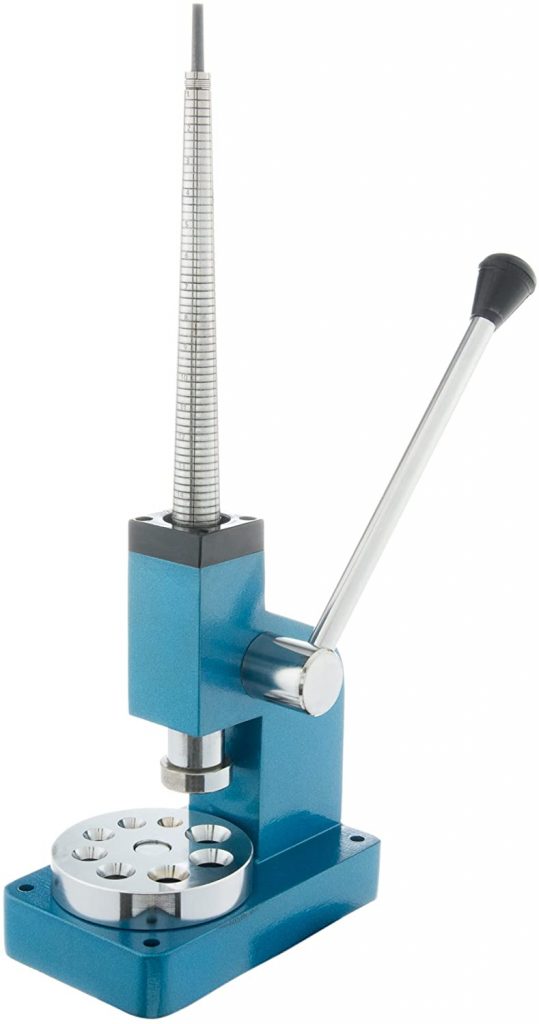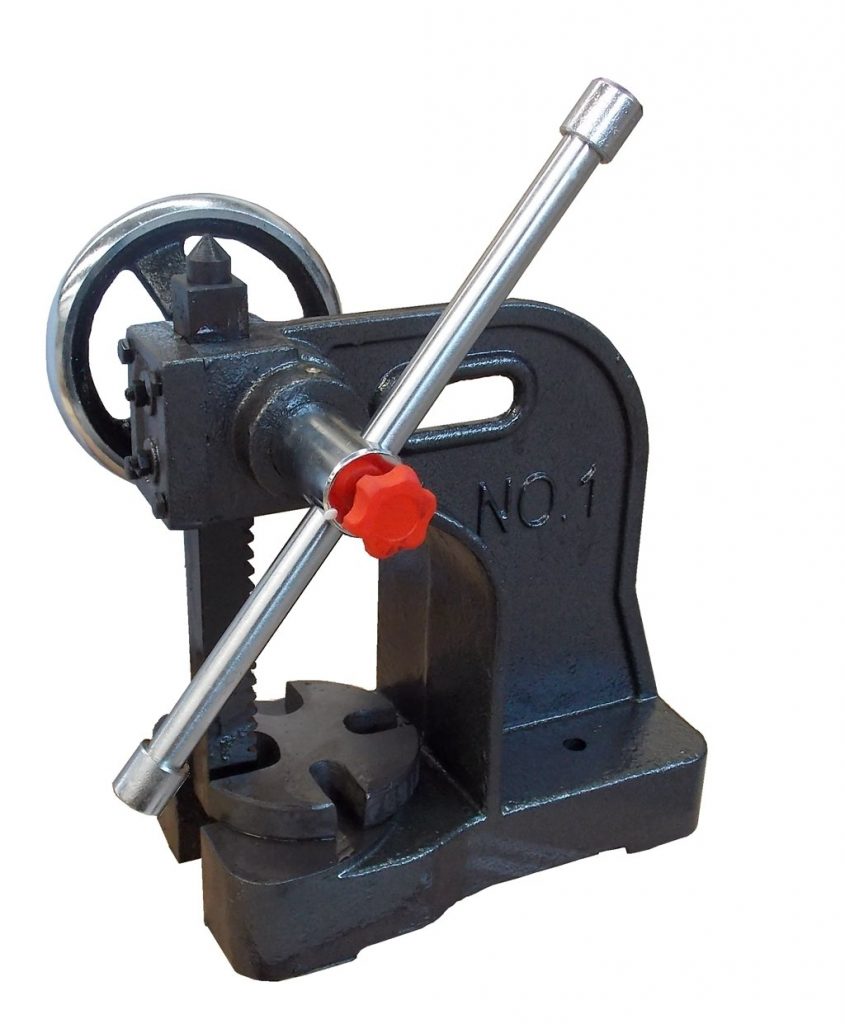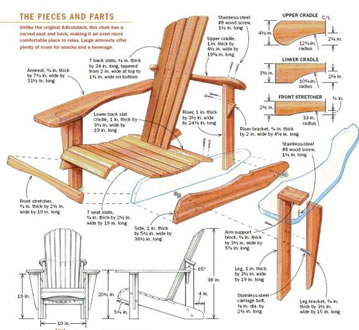In 1883, an engineer and general inventor, Robert Greenerd, took out a patent for a small hand-operated machine which was named a press and since then, the arbor press has been used through the years. This leaves us the question of what exactly is an arbor press and its uses.

An arbor press is a small hand operated tool that uses gear theory to multiply its leverage when pressing. The arbor press comes in different shapes and ratings and has multiple uses. They are used in woodworking shops, jewelry makers, metalwork, and other industries to punch holes, shape metal, or fit bearings.
In this post, we explore the uses of arbor presses and the different types available to you.
What are Arbor Presses Used for?
An arbor press is used to add a slow, steady pressure to items or specific sections of an object. Any object that can be fitted into the throat of an arbor press can be pressed according to specific needs. With the arbor press, you can choose to cut, punch holes, or emboss objects by simply changing the tool head attached to the arbor press.
In the design and leatherworks industry, arbor presses are used for cutting out patterns from leather. In this case, the arbor press presses the shape onto the leather surface until the pattern is produced. In the jewelry industry, the arbor press is also commonly used as a cutting, punching, and pattern embossing tool. The force an arbor press provides has the ability to punch through some metals without damaging the surface, unlike other pressing options.
In the automobile industry, the arbor press also features as a mandril press. Here, the arbor press is used for press-fitting bearings and embossing metal objects that fit in its throat. The arbor press is also used in woodworking for creating patterns and metalwork that enhance the functions or aesthetics of a woodworker’s piece.
This list highlights the fact that the arbor press is used across diverse industries for different tasks. This has always been so since its founding in the 19th century.
How an Arbor Press Works
The arbor press is a compact machine with different parts working together to produce a press. The components of the arbor press include the ram, a recoil spring, a lever arm, an arm stop, the press caul, and the arbor base. When using an arbor press, the item to be pressed is placed on the base and the lever arm is pulled down.
Pulling down the lever arm turn an internal pinion cog the pinion gear rotates along with the toothed rack of the ram which forces the press caul onto the workpiece. This action leaves its mark on the workpiece which gives you your pressed item.
Applying the lever arm generates the required pressing pressure and this pressure is determined by the diameter and the number of teeth in the pinion and rams gear arrangement. The pressure a press provides also decides the ratings used in categorizing arbor presses on sale.
This rating is the tonnage rating. Tonnage rating is the maximum pressure a press can safely provide when putting to use. Thus, when purchasing an arbor press, look out for the tonnage rating and the force it can safely provide.
Types of Arbor Presses
There are different types of arbor presses but only three are popular because of their commercial success and widespread use. These three include the following:
The single lever press
The single lever press is the more common arbor press, and you are likely to see it more often than other options. The single leverage arbor press has few moving parts and is generally rated from 0.5 to 4 tons. The few components within this press make it easy to use, and all you need to do is pull the lever arm to press objects. The four main parts of a single lever press include the handle, the pinion, the rack or the ram, and the frame.
The ratchet press
This press comes with a handwheel which helps with positioning the ram to apply maximum pressure. The handwheel is also the differentiating factor when compared to other presses. Once you see a press with a hand wheel by its side, it’s most likely a ratchet press.
The compound leverage press
The compound leverage press is used for heavy applications and serves as more of a professional-grade arbor press than a DIY tool. The compound leverage press is capable of delivering pressure above the 6-ton mark. If the need arises, the compound leverage press can also be converted to a single leverage press.
Arbor Presses to Consider Purchasing
When purchasing an arbor press, the things to look out for are its tonnage rating and if it is fit for the purpose you intend to use it for. If DIY pressing is your plan, then the single lever press may be the better option and here are some arbor presses to consider purchasing:
Palmgren AP05 0.5 Ton Arbor Press
This arbor press is made from cast iron and integrates a steel ram powered by a milled pinion. The press has a 0.5 tonnage rating which is enough for your DIY projects.

SE JT148RR Ring Stretcher and Reducer
This is a common arbor press used by jewelers to stretch and reduce rings. The press is made from cast iron and has a tonnage rating of 0.5. The SE arbor press is a bit expensive and you will have to part with at least $160 to get a new one.

HHIP Robust Press
This is a single lever press for DIYers. It is easy to use and one of the more affordable options out there. You can purchase the HHIP press for $50 and for this you get a press with a 0.5 tonnage rating with 4 position steel anvil.

BestEquip Screw Press
This is a ratchet press with a 1-ton rating and made from premium iron. The ratchet press is great for personal projects and commercial use due to the stability and pressure it provides. The press is affordable and costs within the $70 to $90 range.

The Best Arbor Press Features
When considering the best arbor press to purchase, you must keep a few things in mind.
- Working Height: The working height of your arbor press is important because it defines its ability to operate when it comes to various tasks. The driving pressure of the arbor press also varies based on the working height.
- Capacity: The capacity of the arbor press is given in a ton unit. It will differ for each application. A greater capacity is needed for heavy-duty jobs, while a small hand operated press with a half-ton capacity is suitable for household applications.
- Build Quality: The quality of the brand you choose is also important. The quality of the tool determines how many years of use you will get out of it.
How Much Tonnage Does Your Arbor Press Need?
Since there are so many uses for an arbor press, the answer to this question can be difficult to reach. A bigger arbor press gives you more throat space. This is the space behind the ram and the bolster plate beneath the ram.
The horizontal and vertical space here is something to pay attention to. A larger arbor press with more tonnage is best suited for large and unusually shaped objects.
Additionally, if you need 1 tonnage worth of pressure, you want to consider a 2 or 3-ton arbor press. Three tons or more are recommended for metalworking.
Hydraulic Press vs Arbor Press
When it comes down to a hydraulic press vs arbor press, it really comes down to your needs and what you are doing. There is little to no feel to it when you use a hydraulic press. If you are working with items at lower pressures or low production parts, you will find that the “feel” aspect of a manual press is important, and an arbor press is the best option.
On the other hand, a hydraulic press is designed for tougher jobs that require high tonnage, variable controls, and high production. A hydraulic press is also more flexible, and the programmable movements allow for better accuracy.
Summary
Arbor presses are versatile tools for cutting, punching holes, embossing patterns, and adding pressure on items. It is one of those tools you purchase and keep within your workshop as a need for it will come up sooner than later.
Arbor Press FAQ
Still have questions about the arbor press, how it works, or what it can be used for? Review the answers to some of the more commonly asked questions below.
What kind of base does an arbor press use?
A shop press can be mounted onto a workbench, wall, or pedestal. The base is usually made of a cast metal material. To mount the arbor press, you should use bolts in the holes of the base to secure the press. The workbench you use should also be secured to the floor for more safety and stability.
Can you use a drill press as an arbor press?
While a drill press may look similar to an arbor press, it doesn’t mean they can accomplish the same things and shouldn’t be used in the same way. An arbor press can deal with larger loads, while a drill press might cause damage. The drill press isn’t designed to handle as much weight and pressure as an arbor press.
Can you press wheel bearings with an arbor press?
You can use a manual arbor press or pneumatic press for press-fitting and replacing wheel bearings. Since an arbor press is a small hand operated press, it can be used for small jobs like staking, riveting, installing, configuring, and removing wheel bearings and other press work.
